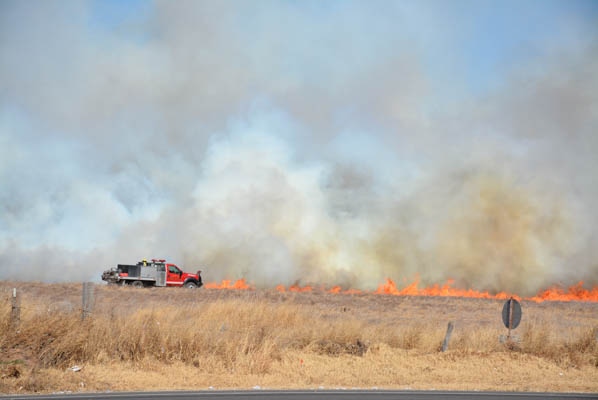September 3, 2020

This week, a multi-day rain event decreased the wildfire potential over a large portion of Texas. But in Southwest Texas, where critically dry fuels remain, so does the possibility for wildfire ignitions.
“An early, and welcomed, transition from summer to fall has occurred with the multi-day rainfall and cooler temperatures observed earlier this week,” said Luke Kanclerz, Texas A&M Forest Service fire analyst in a Set. 3, 2020, press release. An increase in fuel moisture decreased fire potential east of a line from Amarillo south to Abilene and Austin, he said.
But weekend thunderstorms forecast in the southwest have officials concerned.
“The greatest potential for fire occurrence through Monday will remain southwest of San Angelo due to the threat of lightning ignitions over dry to critically dry fuel beds Friday and Saturday,” said Kanclerz. This past week, thunderstorm activity was responsible for several fire ignitions over portions of Texas.
Fire activity
In the last seven days, state and local resources have responded to 102 fires that have burned 24,928 acres. This includes many large, multi-day fires including the Smith Canyon Fire in Pecos County, which has burned an estimated 11,000 acres and is only 25% contained.
Many of the recent wildfire starts are due to human activities, such as equipment use and debris burning. In August, 181 fires, consuming 1,647 acres, were blamed on debris burning.
Fire officials warn that though some areas of Texas have received rainfall, the public does not need to assume it's safe to burn.
“Across the state, our number one ignition source of human-caused wildfires continues to be debris burning,” said Wildland Urban Interface Specialist Weldon Dent, Texas A&M Forest Service. “Waiting to burn until after a rain event may seem like a good idea, but depending on the amount and duration of the rain, vegetation may not have received sufficient moisture to counter the effects of a prolonged dry period. Just because it rained yesterday, doesn’t mean we can let our guards down and cut corners when burning debris.”
When clearing and disposing of debris, fire officials urge the public to be mindful that wildfires can occur at any time, even after the rain. They recommend the following while clearing and disposing of storm debris:
Wear proper personal protective equipment and use safe work practices while operating equipment such as chainsaws and chippers.
Always follow local outdoor burning regulations. Check with local officials for restrictions or burn bans
Check if your community has an approved communal burn pile or has designated days for debris pickup.
Be aware of current and expected weather conditions. Delay burning if the weather conditions are, or will be, hot, dry and windy.
Prepare a safe burning site by clearing at least 10 feet around the burn site of any vegetation or other burnable material. Also avoid any overhead obstructions such as trees, power lines and structures.
Have all tools and a water source on hand before beginning burning.
Allow enough time to stay with your fire until it is out cold.
Since January 1, 2020, debris burning has resulted in 1,099 wildfires and consumed 12,643 acres.
Resources
Aviation resources continue to assist Texas ground crews with water and retardant drops to slow the forward progression of fires and douse hotspots. Fire suppression aircraft have logged approximately 233 hours over the past week, dropping 208,198 gallons of water and 101,820 gallons of retardant on multiple fires including the Smith Canyon Fire; the Swager Creek in Shackelford County (2,272 acres, 100% contained); the Deep Creek Fire in Shackelford County (3,971 acres, 100% contained); and the Ferguson Fire in Reagan County (1,184 acres, 100% contained).
Staged aviation resources include two airtankers, two Type 1 helicopters, three Type 3 helicopters, 11 single engine air tankers, three air attack platforms, and one aerial supervision module.
Since January 1, 2020, state and local resources have responded to 4,239 fires that have burned 215,603 acres and aviation resources have flown 2,223 hours, dropping 2,295,490 gallons of water and retardant on Texas wildfires.
Due to significant fire activity across the country and the heavy commitment of shared resources to large fires, the National Multi-Agency Coordinating Group has raised the National Preparedness Level to Level 5.
Preparedness Levels are dictated by fuel and weather conditions, fire activity, and fire suppression resource availability throughout the country. Level 5 is the highest level of wildland fire activity and indicates heavy resource commitment to fires nationally. Texas is currently at a Level 4 with increased resource commitment and wildfire activity statewide.
In addition to wildfire response across the state, 80 Texas A&M Forest Service personnel are assisting with Hurricane Laura response efforts, providing planning and logistical support as well as debris removal assistance for recovery operations to Texas Division of Emergency Management.
For wildfire and incident updates, follow the Texas A&M Forest Service incident information Twitter account, https://twitter.com/AllHazardsTFS. For current conditions and wildfire outlook, check out the Texas Fire Potential Outlook: https://bit.ly/3kemhbG.
About the Author(s)
You May Also Like






